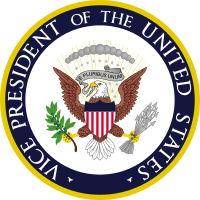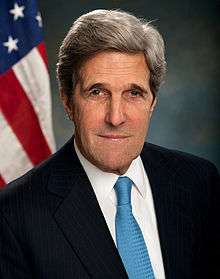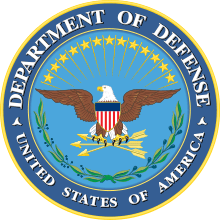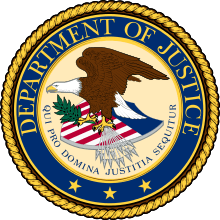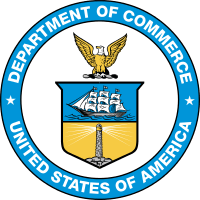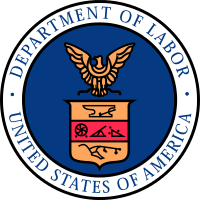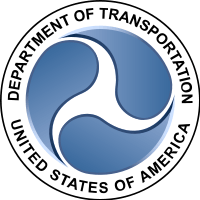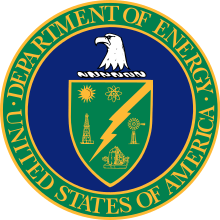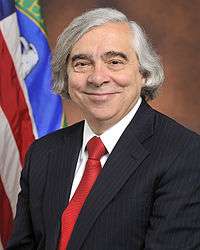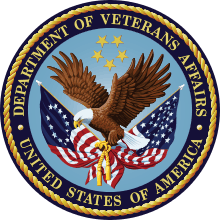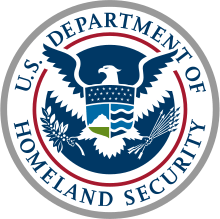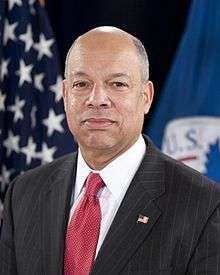Cabinet of the United States
| This article is part of a series on the |
| Politics of the United States of America |
|---|
 |
|
Legislature
|
The Cabinet of the United States is composed of the most senior appointed officers of the executive branch of the federal government of the United States, who are generally the heads of the federal executive departments. The existence of the Cabinet dates back to the first President, George Washington, who appointed a Cabinet of five people to advise him and to assist him in carrying out his duties (his cabinet also included Vice President John Adams):
- Secretary of State Thomas Jefferson
- Secretary of the Treasury Alexander Hamilton
- Secretary of War Henry Knox
- Attorney General Edmund Randolph
- Postmaster General Samuel Osgood.
All Cabinet members are nominated by the President and then presented to the Senate for confirmation or rejection by a simple majority (although, before use of the nuclear option during the 113th US Congress, they could have been blocked by filibuster, requiring cloture to be invoked by 3/5 supermajority to further consideration). If approved, they are sworn in and then begin their duties. Aside from the Attorney General, and the Postmaster General when it was a Cabinet office, they all receive the title of Secretary. Members of the Cabinet serve at the pleasure of the President; the President may dismiss or reappoint them (to other posts) at will.
In federal law and the Constitution
There is no explicit definition of the term "Cabinet" in the United States Constitution, the United States Code, or the Code of Federal Regulations. The name comes from a 17th-century usage for a private room where advisors would meet, which developed into the modern sense of a council of advisors.[1]
The term "principal Officer in each of the executive Departments" is mentioned in Article II, Section 2, Clause 1, and the term "Heads of Departments" is mentioned in Article II, Section 2, Clause 2. The term "principal officers of the executive departments" is also mentioned in the Twenty-fifth Amendment, Section 4. The executive departments are listed in 5 U.S.C. § 101. Although there are occasional references to "Cabinet-level officers," which when viewed in their context do refer to these "principal officers" and "heads of departments," the terms "principal officers" and "heads of departments" are not necessarily synonymous with "Cabinet" members.
In 3 U.S.C. § 302 with regard to delegation of authority by the President, it is provided that "nothing herein shall be deemed to require express authorization in any case in which such an official would be presumed in law to have acted by authority or direction of the President." This pertains directly to the heads of the executive departments as each of their offices is created and specified by statutory law (hence the presumption) and thus gives them the authority to act for the President within their areas of responsibility without any specific delegation.
Under the 1967 Federal Anti-Nepotism statute, federal officials are prohibited from appointing their immediate family members to certain governmental positions, including those in the Cabinet.[2]
Salary
Cabinet officials receive an amount of pay determined by Title 5 of the United States Code. According to 5 U.S.C. § 5312, Cabinet level positions qualify for Level I pay, which was set at an annual salary of $205,700 in 2016.[3]
Current Cabinet and Cabinet-rank officials
The individuals listed below were nominated by President Barack Obama to form his Cabinet and were confirmed by the United States Senate on the date noted. An elected Vice President does not require Senate confirmation, nor does the White House Chief of Staff, which is an appointed staff position of the Executive Office of the President.
These appointments will expire with the administration of President Obama, at which time they will be succeeded by the Cabinet of Donald Trump.
Cabinet
The current Cabinet includes the Vice President and the heads of 15 executive departments, listed here according to their order of succession to the Presidency.[4] Note that the Speaker of the House and the President pro tempore of the Senate follow the Vice President and precede the Secretary of State in the order of succession, but both are in the legislative branch and are not part of the Cabinet.
Cabinet-level officials
The following officials have positions that are considered to be of Cabinet level, but which are not part of the Cabinet:
| Cabinet-level Officials | ||
|---|---|---|
| Office | Incumbent | Term began |
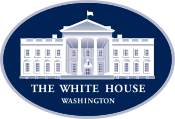 White House Chief of Staff (Pub.L. 76–19, 53 Stat. 561, enacted April 3, 1939, Executive Order 8248, Executive Order 10452, Executive Order 12608) |
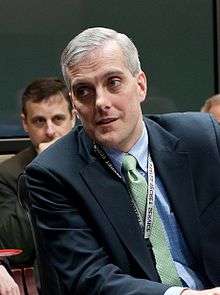 |
January 25, 2013 (without Senate confirmation) |
 Director of the Office of Management and Budget (3 U.S.C. § 301, Executive Order 11541, Executive Order 11609, Executive Order 11717) |
 |
July 28, 2014 |
 Administrator of the Environmental Protection Agency (5 U.S.C. § 906, Executive Order 11735) |
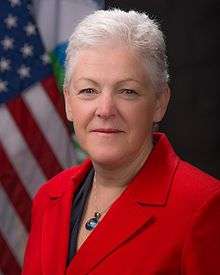 |
July 18, 2013 |
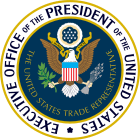 Trade Representative (19 U.S.C. § 2171) |
 |
June 21, 2013 |
 Ambassador to the United Nations (Executive Order 9844, Executive Order 10108) |
 |
August 2, 2013 |
 Chair of the Council of Economic Advisers (15 U.S.C. § 1023) |
 |
August 2, 2013 |
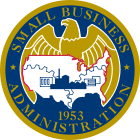 Administrator of the Small Business Administration (15 U.S.C. § 633) |
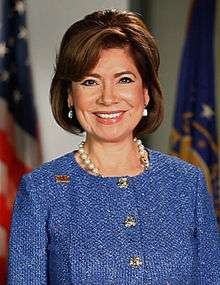 |
April 7, 2014 |
Former executive and Cabinet-level departments
- Department of War (1789–1947), headed by the Secretary of War: renamed Department of the Army by the National Security Act of 1947.
- Department of the Navy (1798–1949), headed by the Secretary of the Navy: became a military department within the Department of Defense.
- Post Office Department (1829–1971), headed by the Postmaster General: reorganized as the United States Postal Service, an independent executive agency.
- National Military Establishment (1947-1949), headed by the Secretary of Defense: created by the National Security Act of 1947 and recreated as the Department of Defense in 1949.
- Department of the Army (1947–1949), headed by the Secretary of the Army: became a military department within the Department of Defense.
- Department of the Air Force (1947–1949), headed by the Secretary of the Air Force: became a military department within the Department of Defense.
Renamed heads of the executive departments
- Secretary of Foreign Affairs: created in July 1781 and renamed Secretary of State in September 1789.[5]
- Secretary of War: created in 1789 and was renamed as Secretary of the Army by the National Security Act of 1947. The 1949 Amendments to the National Security Act of 1947 made the Secretary of the Army a subordinate to the Secretary of Defense.
- Secretary of Commerce and Labor: created in 1903 and renamed Secretary of Commerce in 1913 when its labor functions were transferred to the new Secretary of Labor.
- Secretary of Health, Education, and Welfare: created in 1953 and renamed Secretary of Health and Human Services in 1979 when its education functions were transferred to the new Secretary of Education.
Other positions no longer of Cabinet rank
- Director of the Federal Security Agency (1939–1952): Abolished, most duties transferred to the Department of Health, Education, and Welfare
- Director of the Federal Emergency Management Agency (1996–2001): created as an independent agency in 1979, raised to Cabinet rank in 1996,[6] and dropped from Cabinet rank in 2001.[7]
- Director of Central Intelligence (1995–2001)[8][9][10]
- Director of the Office of National Drug Control Policy (1993–2009)[11][12]
Proposed Cabinet departments
- U.S. Department of Commerce and Industry (proposed by business interests in the 1880s)
- U.S. Department of Agriculture and Labor (proposed by members of U.S. Congress)
- U.S. Department of Peace (proposed by Congressman Dennis Kucinich, Senator Matthew Neely, and other members of the U.S. Congress)[13]
- U.S. Department of Public Welfare (proposed by President Warren Harding)
- U.S. Department of Natural Resources (proposed by former President Herbert Hoover, the Eisenhower administration, 1976 GOP national platform,[14] and Bill Daley as a consolidation of the Departments of the Interior and Energy, and the EPA.)[15]
- U.S. Department of Social Welfare (proposed by President Franklin Roosevelt)
- U.S. Department of Public Works (proposed by President Franklin Roosevelt)
- U.S. Department of Conservation (proposed by Interior Secretary Harold L. Ickes)
- U.S. Department of Urban Affairs (proposed by President John F. Kennedy)
- U.S. Department of Business and Labor (proposed by President Lyndon Johnson)
- U.S. Department of Community Development (proposed by President Richard Nixon; to be chiefly concerned with infrastructure)
- U.S. Department of Human Resources (proposed by President Richard Nixon; essentially a revised Department of Health, Education, and Welfare)
- U.S. Department of Economic Development (proposed by President Richard Nixon; essentially a consolidation of the Departments of Commerce and Labor)
- U.S. Department of Environmental Protection (proposed by Senator Arlen Specter)
- U.S. Department of International Trade (proposed by the Heritage Foundation)
- U.S. Department of Global Development (proposed by the Center for Global Development and others)
- U.S. Department of Culture (proposed by Quincy Jones)[16]
- U.S. Department of Business (proposed by President Barack Obama)[17]
- U.S. Department of Intelligence (proposed by former DNI Mike McConnell)[18]
Gallery
-
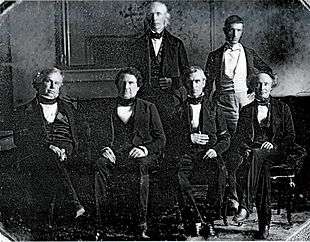
James K. Polk and his Cabinet in 1846. The first Cabinet to be photographed.
-
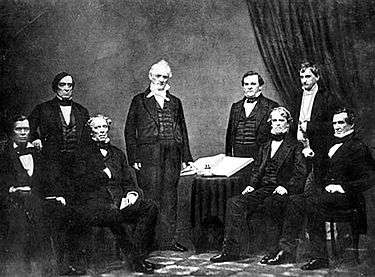
President Buchanan and his Cabinet
-

Abraham Lincoln met with his Cabinet for the first reading of the Emancipation Proclamation draft, (July 26, 1862).
-

President Theodore Roosevelt's Cabinet
-

President William H. Taft's second cabinet, 1912
(photographed by Harris & Ewing photo studio) -
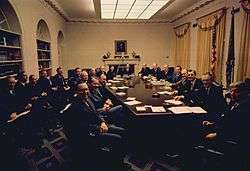
The Nixon Cabinet, 1969
-

President Gerald R. Ford meeting with his Cabinet (June 25, 1976)
-

President Jimmy Carter's Cabinet meeting (February 13, 1978)
-

President Reagan and his Cabinet (September 11, 1986)
-

President George H. W. Bush and his Cabinet in the Cabinet Room (September 5, 1989).
-

The Clinton Cabinet, in 1993.
-

The Bush Cabinet (February 2008).
-
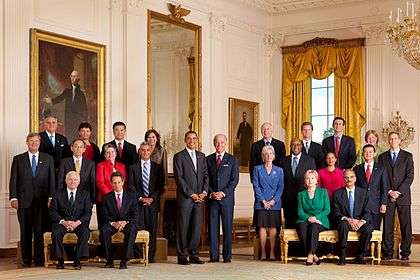
The first Obama Cabinet (September 2009).
See also
- Black Cabinet
- Brain trust
- Kitchen Cabinet
- List of African-American United States Cabinet Secretaries
- List of female United States Cabinet Secretaries
- List of foreign-born United States Cabinet Secretaries
- List of living former members of the United States Cabinet
- List of people who have held multiple United States Cabinet-level positions
- List of United States political appointments that crossed party lines
- St. Wapniacl (historical mnemonic acronym)
For navigational boxes containing the names of members of each President's Cabinet, see:
References
- ↑ Harper, Douglas. "cabinet (n.)". Online Etymology Dictionary. Archived from the original on December 18, 2011. Retrieved March 31, 2015.
Meaning "case for safe-keeping" (of papers, liquor, etc.) is from 1540s, gradually shading to mean a piece of furniture that does this. Sense of "private room where advisors meet" (c.1600) led to modern political meaning (1640s); perhaps originally short for Cabinet council (1630s); compare board (n.1) in its evolution from place where some group meets to the word for the group that meets there.
- ↑ Wulwick, Richard P.; Macchiarola, Frank J. (1995). "Congressional Interference With The President's Power To Appoint" (PDF). Stetson Law Review. XXIV: 625–652.
- ↑ Obama, Barack (2014-12-19). "ADJUSTMENTS OF CERTAIN RATES OF PAY" (PDF). EXECUTIVE ORDER 13686. The White House. Retrieved 2015-09-18.
- ↑ The White House. "The Cabinet". Retrieved June 20, 2015.
- ↑ The office of Secretary of Foreign Affairs existed under the Articles of Confederation from October 20, 1781 to March 3, 1789, the day before the Constitution came into force.
- ↑ "President Clinton Raises FEMA Director to Cabinet Status" (Press release). Federal Emergency Management Agency. February 26, 1996. Archived from the original on January 16, 1997. Retrieved May 22, 2009.
- ↑ Fowler, Daniel (November 19, 2008). "Emergency Managers Make It Official: They Want FEMA Out of DHS". CQ Politics. Archived from the original on November 29, 2008. Retrieved March 3, 2010.
During the Clinton administration, FEMA Administrator James Lee Witt met with the Cabinet. His successor in the Bush administration, Joe M. Allbaugh, did not.
(Archived March 3, 2010, by WebCite at http://www.webcitation.org/5ny13zsIv) - ↑ Tenet, George (2007). At the Center of the Storm. London: HarperCollins. p. 136. ISBN 0-06-114778-8.
Under President Clinton, I was a Cabinet member—a legacy of John Deutch's requirement when he took the job as DCI—but my contacts with the president, while always interesting, were sporadic. I could see him as often as I wanted but was not on a regular schedule. Under President Bush, the DCI lost its Cabinet-level status.
- ↑ Schoenfeld, Gabriel (July–August 2007). "The CIA Follies (Cont'd.)". Commentary. Retrieved May 22, 2009.
Though he was to lose the Cabinet rank he had enjoyed under Clinton, he came to enjoy "extraordinary access" to the new President, who made it plain that he wanted to be briefed every day.
- ↑ Sciolino, Elaine (September 29, 1996). "C.I.A. Chief Charts His Own Course". New York Times. Retrieved May 22, 2009.
It is no secret that Mr. Deutch initially turned down the intelligence position, and was rewarded for taking it by getting Cabinet rank.
- ↑ Clinton, Bill (July 1, 1993). "Remarks by the President and Lee Brown, Director of Office of National Drug Control Policy". White House. Retrieved May 22, 2009.
We are here today to install a uniquely qualified person to lead our nation's effort in the fight against illegal drugs and what they do to our children, to our streets, and to our communities. And to do it for the first time from a position sitting in the President's Cabinet.
- ↑ Cook, Dave (March 11, 2009). "New drug czar gets lower rank, promise of higher visibility". Christian Science Monitor. Retrieved March 16, 2009.
For one thing, in the Obama administration the Drug Czar will not have Cabinet status, as the job did during George W. Bush's administration.
- ↑ "History of Legislation to Create a Dept. of Peace".
- ↑ Republican Party Platform of 1976, August 18, 1976;The American Presidency Project; http://www.presidency.ucsb.edu/ws/?pid=25843
- ↑ Thrush, Glenn (November 8, 2013). "Locked in the Cabinet". Politico. Retrieved November 18, 2013.
- ↑ Clarke, Jr., John (January 16, 2009). "Quincy Jones Lobbies Obama for Secretary of Culture Post". Rolling Stone. Retrieved August 19, 2010.
- ↑ "Obama Suggests 'Secretary of Business' in a 2nd Term - Washington Wire - WSJ". The Wall Street Journal.
- ↑ J. Stapelton Roy (June 29, 2007). "A Conversation with Michael McConnell". Council on Foreign Relations. Retrieved January 9, 2013.
Further reading
- Bennett, Anthony. The American President's Cabinet. Houndmills, Basingstoke, Hampshire: Macmillan, 1996. ISBN 0-333-60691-4. A study of the U.S. Cabinet from Kennedy to Clinton.
- Grossman, Mark. Encyclopedia of the United States Cabinet (Santa Barbara, California: ABC-CLIO; three volumes, 2000; reprint, New York: Greyhouse Publishing; two volumes, 2010). A history of the United States and Confederate States Cabinets, their secretaries, and their departments.
- Rudalevige, Andrew. "The President and the Cabinet", in Michael Nelson, ed., The Presidency and the Political System, 8th ed. (Washington, D.C.: CQ Press, 2006).
External links
| Wikimedia Commons has media related to United States Cabinet. |
- Official site of the President's Cabinet
- U.S. Senate's list of Cabinet members who did not attend the State of the Union Address (since 1984)
